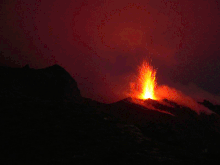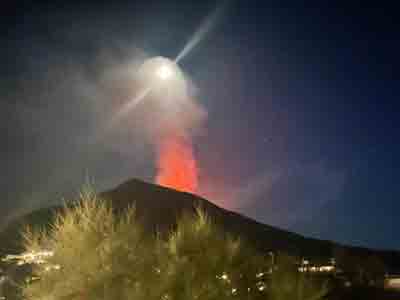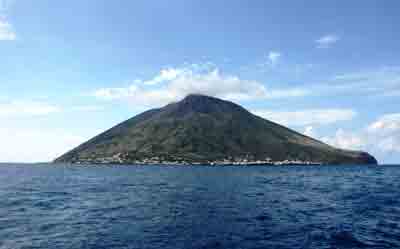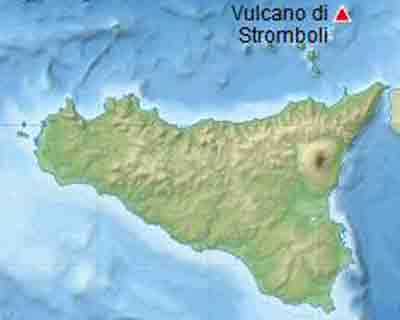Volcanic Lapillus sample 0.8 gr - mm 24 x 15 x 14 Raw Minerals Ash Lava Bombs Stones Rocks for Collection.
Specimen of Volcanic Ember Pumice or fragment of Lava Bomb erupted in 2019 from Stromboli and collected in July on the beach of Mortelle (Messina), only a piece, in plexiglas box 4.2 x 3.7 x 3.2 h, as in photos.
Stromboli is an Italian island belonging to the archipelago of the Aeolian Islands, in

Sicily. Located in the Tyrrhenian basin of the western Mediterranean Sea, the island is the northernmost of the Aeolian Islands and covers an area of 12.2 km². On the island there is the homonymous volcano.
The geological history of the island of Stromboli begins about 160,000 years ago, when a first large active volcano emerges from the sea, in a NE position with respect to the island; of this ancient volcano, which obviously originated the island, only the solidified duct represented by Strombolicchio remains.
Stromboli is an active stratovolcano that is part of the Aeolian arc, and is one of the most active volcanoes in the world. The volcanic building is 926 m above sea level.

and reaches a depth between 1300 m and 2400 m below sea level.
Stromboli is a volcano characterized by regular explosions caused by the burst of gas bubbles that rise faster than the surrounding magma; its eruptions occur with intermittent intervals that can vary from minutes to several hours, during which small quantities of incandescent slag bombs, lapilli, volcanic ash and lithic blocks are emitted, with output speeds ranging from 20 to 120 meters per second and heights ranging from a few tens to a few hundred meters.

The gases emitted mainly consist of water, carbon dioxide, sulfur dioxide and minor amounts of hydrochloric and hydrofluoric acid.
Periods of total inactivity, without material launches, are quite rare. The longest of those recorded lasted for about two years, from 1908 to 1910. Periods of prolonged quiescence, lasting a few months, were recorded several times.
Normal activity can be periodically interrupted by bursts of increased energy, called "major bursts". These events consist of short but violent explosions, during which ballistic launches of blocks and bombs of even metric dimensions are produced at distances of a few hundred meters, associated with showers of lapilli and ash; the distribution of products is usually confined within the crater area.
The paroxysms, on the other hand, represent the most energetic manifestations of the Stromboli volcano; they consist of violent and sudden "cannon-like" explosions, during which the sustained emission of incandescent slag, ashes, bombs and stone blocks occurs at considerable distances, up to affecting the inhabited areas of the island. Such explosions can produce convective clouds that reach altitudes of 10 km. Significantly greater volumes of materials are emitted during paroxysms than in normal and larger eruptions, and profound changes in the crater area can frequently occur.
The most violent Strombolian eruptions ever occurred in historical times date back to 1919 and 1930. For the first and so far only time in the rece

nt history of the volcano, lava flows also poured out of the Sciara del Fuoco, reaching the inhabited centers , causing extensive damage and numerous victims, and even a small tsunami that generated a wave of 2-3 m that came to do damage as far as Calabria.
The morphology of the volcano forces the lava flows to pour onto the north-western slope, where they are confined within the Sciara di Fuoco and therefore do not represent a danger for the population of the island. The flows generally come out through eruptive fractures in the crater area or inside the Sciara del Fuoco, but they can also be generated by overflowing from the crater rim.
On December 30, 2002, a tidal wave of about twenty meters caused six injuries, damage to several boats and triggered the island's evacuation plan.
The last paroxysmal period,
to which it belongs in the sample for sale found on the beaches of Messina, took place starting from 3 July 2019, the day in which strong explosions occurred and the raising of a column of smoke and ash with lava flows and pyroclastic flows from the Sciara del Fuoco. The eruption resulted in one victim.
Lapilli and Tefra
Lapilli are small solid fragments of lava, and more generally of Tefra, which are violently ejected from volcanoes during explosive eruptions.
Volcanologists assign the name pyroclast or clasts to the flying fragments produced during an eruption. Once ashore, clasts are considered Tefra unless they remain hot enough to solidify into pyroclastic rocks or tuff.
The fragments of Tefra are classified as lapilli when they have dimensions between 2 and 64 mm in diameter. Fragments smaller than 2mm are classified as volcanic ash, while fragments larger than 64mm are called volcanic bombs.
The Tefra produced during an eruption therefore range from large boulders, consequently rather close to the volcanic cone, to smaller, volatile fragments capable of being carried by the wind. Ash often travels thousands of kilometers and can remain suspended in the stratosphere for several weeks. If the suspended ash layer is particularly dense and extensive, it can shield the solar radiation thus affecting the earth's climate as well.
Tefra are generally classified as rhyolite, and in many explosive volcanoes they are the product of a viscous magma with a high silicon content.
Tefra are classified according to their size:
- Volcanic ash - particles less than 2mm in diameter
- Lapilli or volcanic embers - between 2 and 64 mm in diameter
- Volcanic bombs or volcanic boulders - over 64mm in diameter
The words "Tefra" and "Pyroclast" both derive from the Greek. "Tefra" means "ash", while Pyro means "fire" and klastos "to break"; thus pyroclast assumes the meaning of "broken by fire".
Pumice
Pumice is a magmatic rock, very light due to its very high porosity.
From a geological point of view, the term is generic and refers to the particular porous texture of the rock. It is mainly formed by explosive eruptions, therefore by acidic, silicate or felsic magmas, but there are also some with a partial mafic component, and the porosity is due to the formation of gas bubbles with a foam-like structure in the glass matrix of the rock.
The rapid cooling maintains the vesicular structure (also forming 90% of the volume while the volcanic slag is less vesiculated), and the solid part is made up of amorphous rock, rarely with a small crystalline component. The solid mass is ultimately made up mainly of silica, with various dissolved metal oxides (aluminum, titanium, iron, manganese and others).
Given its high porosity it is the only stone that floats in water. Having a specific weight lower than that of water, pumice floats based on its spherical cell structure, but communicating with each other in most cases through an incomplete closure; those which, towards the inside of the piece under examination, are not invaded by water allow the stone to float.
Pumice is commonly light in color (for example the north-eastern coast of the Island of Lipari), but it can take on a white, cream, gray, green or black appearance depending on the composition; in the latter two cases, often due to the prevalence of iron, such as the black pumice of the Canary Islands.
It is used in the cosmetic field and in that of industrial washing (stone wash). In construction it is used to lighten concrete and as an acoustic and thermal insulator, both in powder form and in blocks or panels; falls within the approved materials for green building.
Other uses: nursery gardening, absorbent and filtering agent for industrial oils, cleaning of surfaces in general and light abrasive.
Available on our website, besides ashes, pumice and bombs, also various volcanic rocks, such as Apache Teardrops, sulfur, obsidian, tuff, crystal chalk, etc.


